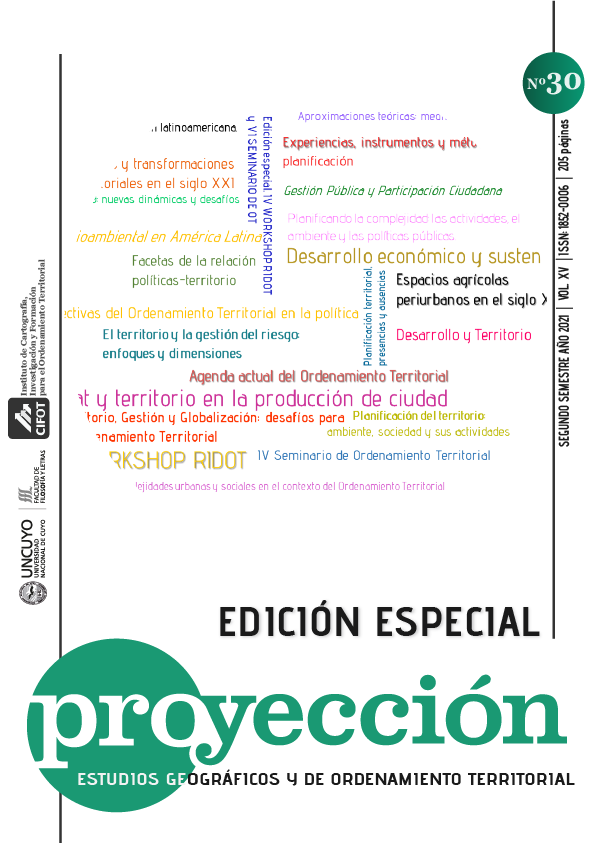Propuesta de un modelo geográfico desde un enfoque de ciudad-región: El caso del municipio de Montería- Colombia (2020)
DOI:
https://doi.org/10.48162/rev.55.012Palabras clave:
Ciudad-región, geografía, corema, modeloResumen
Este artículo tuvo como objetivo proponer un modelo de organización territorial del municipio de Montería (Colombia) desde el enfoque de ciudad región y la coremática. Metodológicamente se hizo una revisión bibliográfica sobre modelos territoriales a través de coremas, como las formas de sintetizar la información estadística, heurística y de diseño en esquemas; se tomó la base cartográfica del municipio, con la que se realiza la delimitación del área de estudio, se identificaron las dinámicas territoriales adaptando lo propuesto por los autores de base Breheny y Rookwood (1994) y Ravetz (2000) con la disponibilidad de información. A partir de variables físico-naturales, sociales, económicas y usos del suelo se determinaron las regiones homogéneas que finalmente se esquematizan en el corema. Como resultado se generó una propuesta de organización territorial a través de un modelo de ciudad región que muestra la estructura del territorio en áreas con características homogéneas en su interior, pero diferenciadas con el resto; lo que facilita su comprensión y sirve como base para su posterior utilización en instrumentos de planeación territorial.
Citas
ALCALDÍA DE MONTERÍA, CÓRDOBA. (2010). Acuerdo 029 del 2010 mediante el cual se adopta la Revisión y Ajuste del Plan de Ordenamiento Territorial del Municipio de Montería 2002-2015. Montería: Concejo Municipal de Montería.
BARTON, J. R. (2006). Sustentabilidad urbana como planificación estratégica. EURE (Santiago), 32(96), 27-45.
BREHENY, M., & ROOKWOOD, R. (1994). Planning the sustainable City Region. In A. Blowers (Ed.), Plannin for a sustainable enviroment (II, p. 238). Town and Country Planning Association.
BRUNET, R. (1993). Building Model for Spatial Analysis. In : Espace géographique. Espaces, modes d'emploi. Two decades of l'Espace géographique, an anthology. Paris, pp. 109-123.
CATHALIFAUD, M. A., & OSORIO, F. (1998). Introducción a los conceptos básicos de la teoría general de sistemas. Cinta de moebio, (3).
DE CHIARA, D., DEL FATTO, V., LAURINI, R., SEBILLO, M., & VITIELLO, G. (2009, September). Visual analysis of spatial data through maps of chorems. In Proceedings of the 15th International Conference on Distributed Multimedia Systems–Workshop on Visual Languages and Computing VLC2009, San Francisco (USA) (pp. 10-16).
DELER, J. P. (1998). La coremática, un modo de representación de las estructuras y dinámicas del territorio al servicio del análisis regional. Revista de Geografía Norte-Grande, (25), 91-100.
DELGADO MAHECHA, O. (2003). Debates sobre el espacio en la geografía contemporánea. Geografía.
Departamento Nacional de Planeación (2010). Plan Nacional de Desarrollo 2010-2014. Bogotá.https://colaboracion.dnp.gov.co/cdt/pnd/pnd2010-2014%20tomo%20i%20cd.pdf
DEPARTAMENTO NACIONAL DE PLANEACIÓN (DNP). (2020). Terridata. Recuperado 12 de diciembre de 2020 de https://terridata.dnp.gov.co/index-app.html#/perfiles/23001.
DHIEB, M. (2020). Using Chorems in Graphical Modeling: The Case of the Kingdom of Saudi Arabia. Current Urban Studies, 8(2), 265-283.
GAVIRIA, M. (2017). Configuración espacial de la formación urbana regional del Eje Cafetero colombiano. Cuadernos de Geografía: Revista Colombiana de Geografía, 26(1), 155-170.
HIGUERAS ARNAL, A. M. (2003). Teoría y método de la Geografía. Introducción al análisis geográfico regional. Prensas Universitarias de Zaragoza. Zaragoza.
LAURINI, R. (2014). A conceptual framework for geographic knowledge engineering. Journal of Visual Languages & Computing, 25(1), 2-19.
LAURINI, R., MILLERET-RAFFORT, F., & LOPEZ, K. (2006). A primer of geographic databases based on chorems. In OTM Confederated International Conferences" On the Move to Meaningful Internet Systems" (pp. 1693-1702). Springer, Berlin, Heidelberg.
MONTAÑEZ, G. Y DELGADO, O. (1998). Espacio, territorio y región: Conceptos básicos para un proyecto nacional. Cuadernos de Geografía. (7) 121-134 http://acoge2000.homestead.com/files/Montanez_y_Delgado._1998.pdf
MONTOYA, J., & DUQUE, I. (2017). El subsistema de ciudades medias en Colombia y su integración al sistema urbano nacional. Sistemas urbanos y ciudades medias en Iberoamérica, 110-143.
PARR, J. (2005). Perspectives on the city‐region. Regional Studies, 39(5), 555-566.
RAVETZ, J. (2000). City Region 2020. Integrated Planning for a Sustainable Environment. London: Earthscan Publications.
SANTOS, M. (1990). Por una geografía nueva. Madrid, España: Espasa
SERRANO, A. (2003). El modelo territorial europeo: tendencias para el siglo XXI y sus implicaciones para el modelo territorial español. Urban, (8), 35-54.
VIEYRA, A. (2006). Reestructuración sectorial centro-periferia. Los alcances regionales de la ciudad de México. Las grandes aglomeraciones y su periferia regional.
ZOIDO, F. (2006). Modelos de ordenación territorial. Sociedad y medio ambiente. 251-286
ZOIDO, F. N. (2007). Territorialidad y gobierno del territorio, hacia una nueva cultura política. In Territorialidad y buen gobierno para el desarrollo sostenible: nuevos principios y nuevas políticas en el espacio europeo (pp. 19-48). Servei de Publicacions.
Descargas
Publicado
Cómo citar
Número
Sección
Licencia
Derechos de autor 2021 Ana Gladis Peinado Villalobos, Osvaldo Leyva Camacho, Adriana Arias Vallejo

Esta obra está bajo una licencia internacional Creative Commons Reconocimiento-NoComercial-CompartirIgual 3.0.
La revista Proyección establece las siguientes condiciones de publicación para los/as autores/as:
- Los/as autores/as conservan los derechos de autor y ceden a la revista el derecho de publicación bajo la Licencia Creative Commons Atribución-No Comercial-CompartirIgual 3.0 No portada (CC BY-NC-SA 3.0) que permite a terceros copiar, distribuir, exhibir y ejecutar la obra citando siempre la fuente y los datos de autoría según la norma prevista por la Revista Proyección. Esta licencia no permite el uso de la obra con fines comerciales.
- Todos los trabajos publicados por Proyección, Estudios Geográficos y de Ordenamiento Territorial serán bajo la modalidad de gratuidad para autores/as y lectores/as.




























